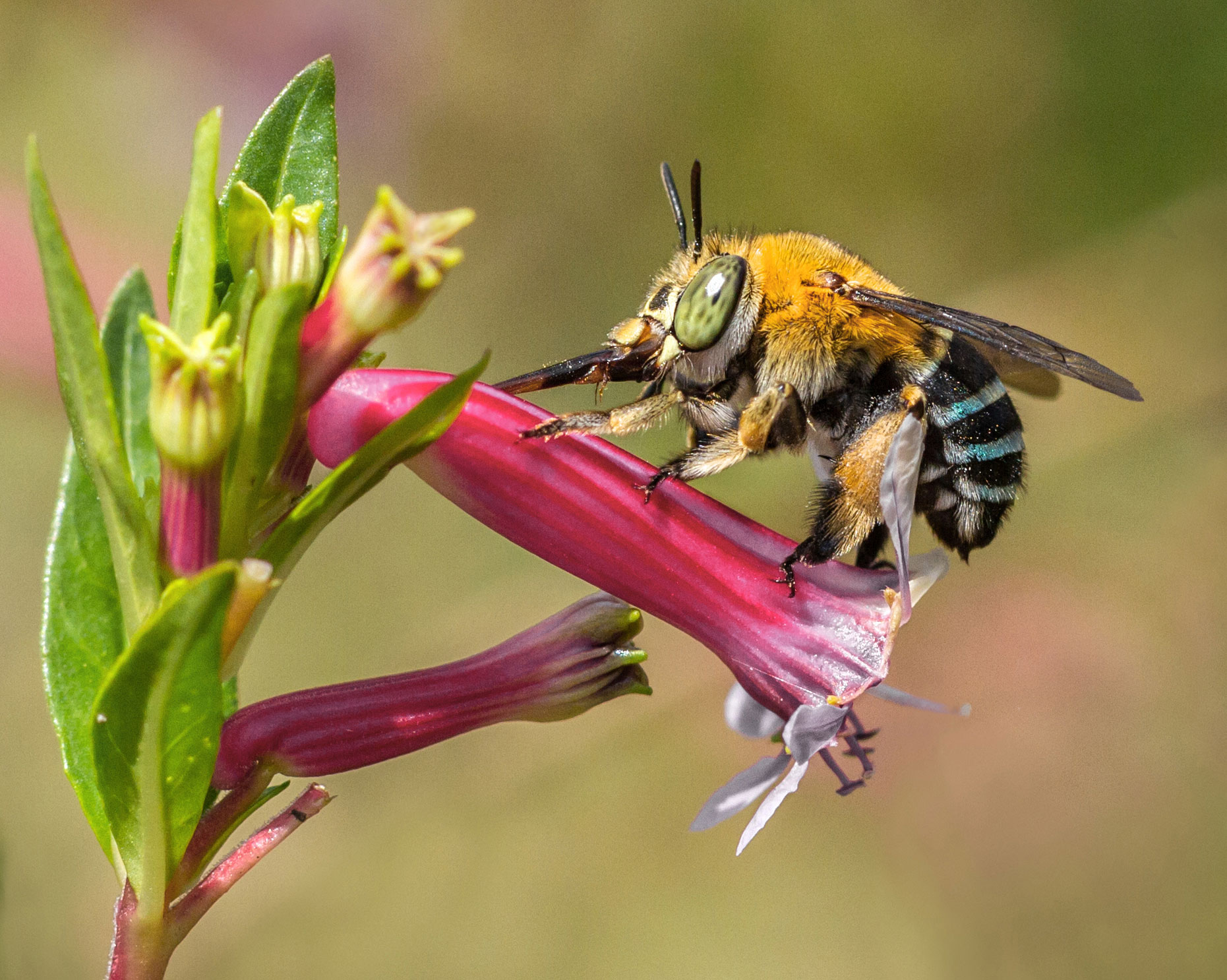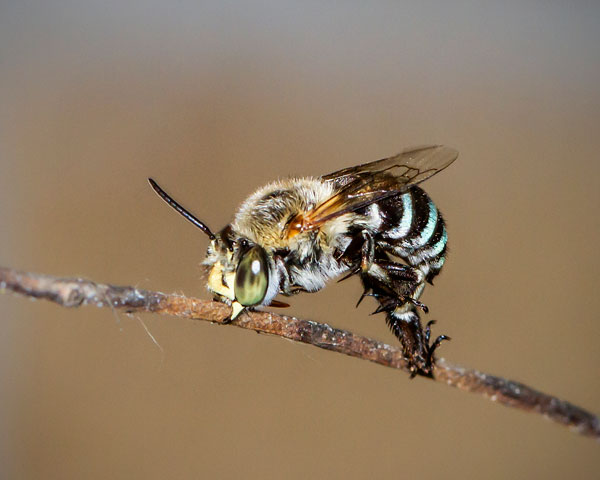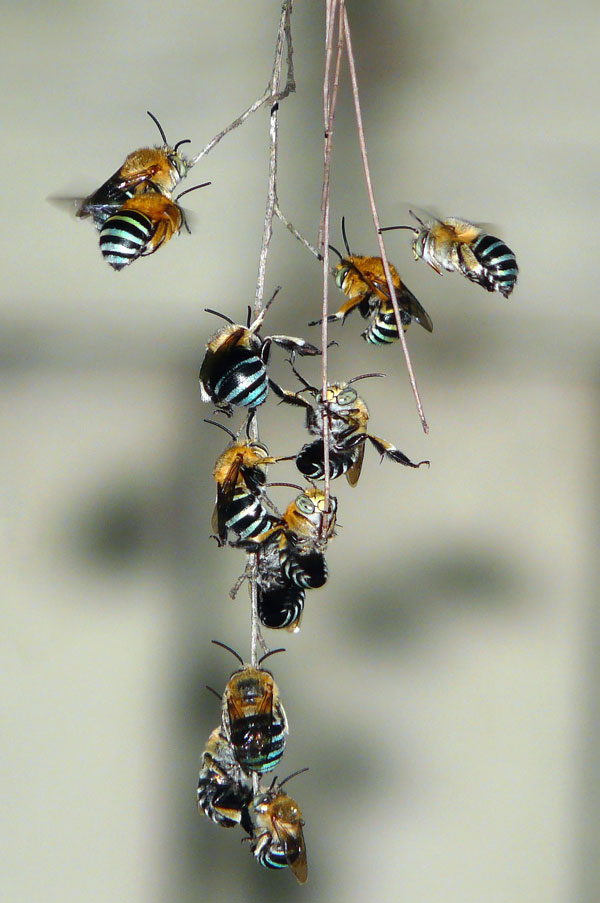There are eleven species of described blue-banded bees in Australia ranging in size from 8-14 mm. They are also known as long-tongued bees or buzz pollinators. Blue-banded bees are solitary and are found in all states of Australia except Tasmania. They have a sting but are not aggressive.
They have thick, reddish-brown fur on their thorax and a black abdomen with iridescent blue, whitish, green or reddish furry stripes. The colours are caused by microscopic diagonal stripes engraved on each hair which reflect light causing these glittering colours. Males have five stripes and females have four. Their faces have yellow, cream or white markings.

Header: This female blue-banded bee is robbing nectar by piercing the ower petals with her straw-like brown sheath that protects her tongue.
Blue-banded bees forage on a variety of exotic and native flowers such as Hibbertia scandens, Melastoma malabathricum subsp malabathricum, tomato, chilli, basil, buddleia, lavender, abelias, Leucophyllum and cigar plants (Cuphea). Research has shown that blue-banded bees could be valuable pollinators of greenhouse tomatoes.
Females build their own nest and are attracted to areas where other females are nesting. Nests are built in soft mortar, mud bricks or soft sandstone banks in sheltered positions. Females use their jaws to dig burrows. Inside the burrows, they create oval-shaped cells lining them with waterproof secretions.

(Above:) A male blue-banded bee roosts at night suspended by his mandibles.
(Right:) A group of male blue-banded bees roost together. Males have five abdominal bands, whereas females have only four.

Before depositing an egg, a mixture of nectar and pollen is placed in the cell. Once an egg has been deposited each cell is capped, and when all cells are filled and capped the burrow is closed with a layer of soil. The female then goes in search of another nesting site.
According to J. C. Cardinale (Australian National Insect Collection, Canberra 1968), blue-banded bees live for about 40 days and about three generations hatch during one summer. Baby bees take about seven weeks to hatch and those that do not hatch due to approaching winter, overwinter in their cells, emerging in the following spring.
Male blue-banded bees roost together in small groups at night, out in the open, hanging onto twigs or stems with their mandibles. They vigorously shake their legs and wiggle their abdomens when a new bee arrives to settle. Eventually they all tuck their legs under their bodies to sleep. After warming up in the morning they go on their daily routine of foraging and finding a female to mate with.
Blue-banded bees can be attracted to your garden by making a mud brick. Drill a variety of holes 10-15 mm wide and 25- 50 mm deep before the mud brick dries and place the finished brick in a sheltered position. Alternatively, you can use an extruded brick with core holes, in which the holes are filled with mud. When the mud dries, drill holes for the bees.
Placing soil from an existing blue-banded bee nesting site on top of the brick will help attract females to the new nest. For more information on creating bee walls, there is an excellent factsheet available from www.permaculturenoosa.com.au > How to > Instructions for a Bug Hotel.
References & Further Reading
Cardinale, JC (1968) Australian National Insect Collection, Canberra.
Hogendoorn K, Coventry S, Keller MA (2007) Foraging behaviour of a blue banded bee, Amegilla chlorocyanea in greenhouses: implications for use as tomato pollinators. Apidologie 38 (1) 86-92.
Owen, R (2015) The Australian Beekeeping Manual. Exisle Publishing Pty Ltd.
aussie.com.au
Bees Suborder Apocrita
Bees Business
Native Bees
Article and photos by Erica Siegel Native bee enthusiast

The photo of the sleeping bleu-banded bees is great. I am working on a book on mouthparts of bees. It would be great if I could use it. Would you allow me to use this photo in a contribution about functions of mouthparts in other contexts than feeding?
Best regards
Harald
she is not sleeping, she is robbing nectar
The second picture is a male roosting.
Harald is talking about the male blue-banded bees roosting.
In all of my 65 plus years, living in this area, Mary Valley, QLD., I have never seen a blue banded bee until today, when I noticed 2 taking nectar from the flowers of basil in my vegetable garden. Tomorrow I will arm myself with a camera and see if I can get a photo of them.
I saw some of these bees for the first time today. There were two and they were feasting on the small purple flowers on the stem of my colus plant. I was mesmerized.
Hi Everyone,
We have hundreds of blue banded bees living in our mud brick wall at the rear of the house. We have tried several of the suggested ways to get them to leave but they are persisting. We are a little concerned they will hollow out the wall. Were not sure what steps we should take – Has anyone got experience with this situation?
Hi Petrina,
There are many sites showing how to make the clay bricks to encourage the bees to nest – perhaps putting these in front of the wall then putting a seal on the wall (even a temporary one for that season) might encourage them to move to the bricks. You could then transport the bricks to other bee lovers and reduce the numbers around your wall a little without harming the bees. Hopefully you find a solution, and good luck.
I am so lucky to have blue banded bees nesting in one wall of my mudbrick house in Healesville Victoria. I have noticed them about 300 metres away from the nest in amongst purple flowers like lavendar and edible geranium. I feel so protective of my little group, that comes back year after year, even after the mudbrick has been rerendered. Knowing a bit more about them means I will try to be very careful with rerendering materials in the future, and possibly stack my four large spare mudbricks near the nesting site so there are more homes to be had.
Hi Inge
I just found your comment about BBBs nesting in your mud brick wall in Healesville. You are lucky. We have attempted to persuade BBBs to nest in bricks of our making in Warrandyte Vic. without success although we have plenty of BBBs feeding on flowers around the native nursery. I have a special interest in native bees and have yet to see them nesting in Victoria. I know that further north people easily persuade them to nest in manmade bricks. Please let me know if you are still getting these native bees in your mudbrick wall.
Kind regards
Hi Inge – I have just read your post and was interested to find that you are encouraging them to nest in the walls of your home? We have this situation at the rear of our house – is it unlikely they will weaken the structure of the wall? We have tried everything to encourage them to leave but to no avail.
After feeling a sting inside my jumper I threw my jumper off to find a blue banded bee crawling across the floor. The bee didn’t seem to be injured and I put it back outside.
There was no sting left in my arm and the reaction was only a mild dot.
So was the sting left somewhere in my jumper or do they even leave a sting behind?
North East Victoria, Australia
No they don’t drop their stinger like honey bees and can sting repeatedly.
Why do you say Blue Banded Bees are not in Tasmania? I most certainly had some in my garden north of Hobart.
1 record only of a blue-banded bee in Tasmania,
Spotted one today in Venus Bay, Victoria hovering over our lavender bush. Very pretty one!
Awaken….knowledge is everything. 🌈.. I am a Aboriginal woman of Kambuwal decent. I have just completed a Art piece re blue bees 🐝 . Please love this beautiful country for all to protect and embrace.
Dear Jen,
Do you sell your blue bee art? I would be very interested.
Regards,
Corry Garam
Hi Corry. Erica’s photography can be found at https://www.ericasiegel-photography.com/. I am not sure if Jen sells her art. Cheers.
I took photos yesterday of a dozen or so blue banded bees in my bright pink flowering sage in my garden at Wiseleigh East Gippsland Victoria
We saw our first BBBs not far from you in Swan Reach 😀
I saw them for the first time this year hovering around Salvia flowers. They were out and about when it was too hot for honey bees.
I have some tiny bees, about the size of a blowfly that come in each evening to roost on my pot plants that have long drooping stems. They’re more a grey stripe and white, but exhibit the same behaviour as these blue banded bees when another bee lands next to them. They also appear to have the same shape and antenna. I counted 21 last night. I do have blue banded bees in my garden but these are different coloured. Can anyone help me identify these darlings?
Hi Karen. This is a great website – https://www.brisbaneinsects.com/brisbane_bees/index.html. As is this one – https://www.aussiebee.com.au/gallery.html
Otherwise there are several Facebook invertebrate identification groups that would also be helpful.
Thankyou so much!
For the first time, I spotted a blue banded bee in my garden in Robina, Gold Coast QLD. It was hovering around flowers on my blue ginger plant; I also have a large flowery blue salvia nearby. Amazing to watch it!
I’m in Perth WA and have seen 2 in the last couple weeks. At first it sounded like a blowfly.
I never thought they’d be this far south.
BBBBBBBzzzzzzzzzzz BBBBBBBzzzzzz i am blue banded bee BBBBBBZZZZZZZZ!!!!
In Murchison area W.A in late Sept.
Clusters of holes the size of a tea cup surrounded by stems, narrow leaves.
We were told they were blue banded bee burrows but they seemed very large for a bee.would anyone be able to have an answer to this query please?
I just saw two beautiful blue banded bees and they were as big as a honey bee. Deep blue almost purple and by themselves. Are they really bees?
Yes. They are native bees.
I just spotted about 4 of these in my garden, flying and landing on tomato flower and cat grass flower spikes. Very exciting. I am trying to regenerate an acre of the semievergreen thicket. Oakey 4401 Queensland Australia
I have snapdragons outside my study window while I WFH (Vic). One BBB has been periodically pushing its way inside the snapdragons and slurping for up to 15 secs (I have video’d this on my phone), and then pushing back out, a quick hover, then off. They are so much quicker than honey bees when they fly – quick hover then a very fast dart. I’ve never seen a honey bee push into a snapdragon like that. I also had a native bee that I think is a reed bee (although others look similar) trying to get into a bamboo tomato stake, but unable to, as fine bird netting part-covered the hole. So I built a bee hotel, with canes and drilled wood. Will try and make some mud bricks and hope the BBBs might use that, as well.
Thank you for explaining what the males are doing when they roost. I have 22 males at present in my front garden. I leave a little patch of uncut paspalum for them because they seem to love sleeping there at night. There must be females nesting nearby because they come back every year in the warmer months. I am definitely going to try and encourage them with a mud brick with holes because I love them. I’ve noticed them on my flowers as well.
I happened to plant flax lily in my garden from our local native plant nursery, not realising that the BBB loves it. It is a hardy plant and I have clumps here and there in the garden now. It’s a thrill to see the bees visiting the purple and yellow flowers this time of year.
Thank you for the informative article.
Wonderful photos! I especially like the photo of the bee robbing nectar. I have seen this occurring in the flowers of Mexican shrimp plant (Justicia sp.).
I have recently been photographing blue-banded bees feeding on a native Plectranthus in my garden in Sydney. Today, for the first time, I saw two bees feeding on an inflorescence at the same time. Then there was an “altercation” which I photoed but the photo was not very good. One bee was definitely a female blue-banded bee with 4 bands. The other bee which I did not capture clearly also has bands but I am not sure whether there are 4 or 5 and the abdomen looks longer, more slender and more tapered than a blue-banded bee. I have seen a leaf cutter bee, Megachile sp. feeding in this plant.
I would like to send the photos to Erica to have a look at if she is interested and to advise whether there are two different species in the photos.
Kind Regards,
Rachel
Hi Rachel. You might like to upload your photos to iNaturalist. It will use AI to suggest an initial identification and then other iNat users will confirm the ID. http://www.inaturalist.org.au